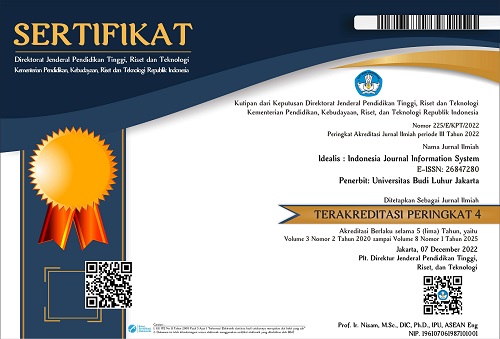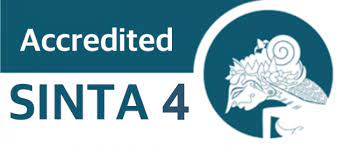IMPLEMENTASI MACHINE LEARNING DALAM PENGELOMPOKAN MUSIK MENGGUNAKAN ALGORITMA K-MEANS CLUSTERING
DOI:
https://doi.org/10.36080/idealis.v8i1.3357Keywords:
Algorithm, Clustering, K-Means, Machine Learning, MusicAbstract
Music is an inseparable part of everyone's life. Many people listen to music but with different preferences because there are so many different types of music available. Many music streaming platforms compete to make song recommendations that suit their users' preferences but it is still difficult to group the music in them. This study aims to analyze music using the K-Means Clustering algorithm, an unsupervised machine learning method, to group songs based on their features such as tempo, tone, and other elements. This research was conducted in the context of the rapidly growing digitalization of music, where music streaming platforms are increasingly popular and allow for personalization of user preferences. The K-Means algorithm is used to find patterns from various music genres, so that it can provide insight into music trends and listener preferences. This study involves several main stages, including data exploration (Exploratory Data Analysis/EDA), checking for missing values and outliers, and selecting relevant features. Furthermore, the clustering process is carried out using the K-Means algorithm with evaluation through the Elbow and Silhouette methods to determine the optimal number of clusters and assess the quality of clustering. This research is expected to contribute to the development of a better music recommendation system by increasing knowledge in the field of machine learning, especially in the application of the K-Means algorithm for music data clustering.
Downloads
References
A. S. Marwi, I. R. Lubis, Y. Sinurat, S. W. Ulfa, and T. H. B. Nainggolan, “PENGARUH MEDIA MUSIK DAN LAGU DALAM PEMBELAJARAN BIOLOGI,” Sinar Dunia: Jurnal Riset Sosial Humaniora dan Ilmu Pendidikan, vol. 2, no. 1, pp. 74–86, Jan. 2023, doi: 10.58192/sidu.v2i1.507.
D. Hesmondhalgh, “Streaming’s Effects on Music Culture: Old Anxieties and New Simplifications,” Cult Sociol, vol. 16, no. 1, pp. 3–24, Mar. 2022, doi: 10.1177/17499755211019974.
Y. Chen, “Automatic Classification and Analysis of Music Multimedia Combined with Hidden Markov Model,” Advances in Multimedia, vol. 2021, pp. 1–7, Dec. 2021, doi: 10.1155/2021/7824001.
A. P. Thenata and M. Suryadi, “Machine Learning Prediction of Anxiety Levels in the Society of Academicians During the Covid-19 Pandemic,” Jurnal Varian, vol. 6, no. 1, pp. 81–88, Nov. 2022, doi: 10.30812/varian.v6i1.2149.
M. Ahmed, R. Seraj, and S. M. S. Islam, “The k-means Algorithm: A Comprehensive Survey and Performance Evaluation,” Electronics (Basel), vol. 9, no. 8, p. 1295, Aug. 2020, doi: 10.3390/electronics9081295.
D. B. Rarasati, “A Grouping of Song-Lyric Themes Using K-Means Clustering,” JISA(Jurnal Informatika dan Sains), vol. 3, no. 2, Dec. 2020, doi: 10.31326/jisa.v3i2.658.
F. Apit, “MACHINE LEARNING UNTUK PENDIDIKAN : MENGAPA DAN BAGAIMANA,” Jurnal Informatika Dan Tekonologi Komputer, vol. 1, no. 3, pp. 57–62, Nov. 2021.
S. Naeem, A. Ali, S. Anam, and M. M. Ahmed, “An Unsupervised Machine Learning Algorithms: Comprehensive Review,” International Journal of Computing and Digital Systems, vol. 13, no. 1, pp. 911–921, Apr. 2023, doi: 10.12785/ijcds/130172.
Md. K. Hasan, Md. A. Alam, S. Roy, A. Dutta, Md. T. Jawad, and S. Das, “Missing value imputation affects the performance of machine learning: A review and analysis of the literature (2010–2021),” Inform Med Unlocked, vol. 27, p. 100799, 2021, doi: 10.1016/j.imu.2021.100799.
A. Alabrah, “An Improved CCF Detector to Handle the Problem of Class Imbalance with Outlier Normalization Using IQR Method,” Sensors, vol. 23, no. 9, p. 4406, Apr. 2023, doi: 10.3390/s23094406.
N. Anwar, F. Adikara, R. Setiyati, R. Satria, and A. Satriawan, “Data Mining Menggunakan Metode Algoritma Apriori Pada Vending Machine Product Display,” JBASE - Journal of Business and Audit Information Systems, vol. 4, no. 2, Aug. 2021, doi: 10.30813/jbase.v4i2.3004.
M. A. H. Umar and B. Sitohang, “ANALISIS FAKTOR-FAKTOR YANG MEMENGARUHI KEPUTUSAN PEMBELIAN PAKET WISATA MENGGUNAKAN MODEL KLASIFIKASI DECISION TREES, RANDOM FOREST DAN K-NEAREST NEIGHBOURS,” Journal of Social and Economics Research, vol. 6, no. 2, pp. 25–39, Aug. 2024, doi: 10.54783/jser.v6i2.590.
C. S. D. B. Sembiring, L. Hanum, and S. P. Tamba, “PENERAPAN DATA MINING MENGGUNAKAN ALGORITMA K-MEANS UNTUK MENENTUKAN JUDUL SKRIPSI DAN JURNAL PENELITIAN (STUDI KASUS FTIK UNPRI),” Jurnal Sistem Informasi dan Ilmu Komputer Prima(JUSIKOM PRIMA), vol. 5, no. 2, pp. 80–85, Feb. 2022, doi: 10.34012/jurnalsisteminformasidanilmukomputer.v5i2.2393.
M. Guntara and N. Lutfi, “Optimasi Cacah Klaster pada Klasterisasi dengan Algoritma KMeans Menggunakan Silhouette Coeficient dan Elbow Method,” JuTI “Jurnal Teknologi Informasi,” vol. 2, no. 1, p. 43, Aug. 2023, doi: 10.26798/juti.v2i1.944.
D. Haversyalapa, S. Puspasari, and R. Gustriansyah, “KLASTERISASI PIXEL CITRA KOLEKSI FOTO MUSEUM MONPERA DENGAN METODE K-MEANS PADA APLIKASI AUGMENTED REALITY,” IDEALIS : InDonEsiA journaL Information System, vol. 7, no. 2, pp. 189–199, Jun. 2024, doi: 10.36080/idealis.v7i2.3175.
A. R. Lashiyanti, I. R. Munthe, and F. A. Nasution, “Optimisasi Klasterisasi Nilai Ujian Nasional dengan Pendekatan Algoritma K-Means, Elbow, dan Silhouette,” Jurnal Ilmu Komputer dan Sistem Informasi (JIKOMSI), vol. 6, no. 1, pp. 14–20, Mar. 2023, [Online]. Available: https://ejournal.sisfokomtek.org/index.php/jikom/article/view/1550
F. M. Ilyas and S. S. Priscila, “An Optimized Clustering Quality Analysis in K-Means Cluster Using Silhouette Scores,” 2024, pp. 49–63. doi: 10.4018/979-8-3693-1355-8.ch004.
R. F. T. Wulandari and D. Anubhakti, “IMPLEMENTASI ALGORITMA SUPPORT VECTOR MACHINE (SVM) DALAM MEMPREDIKSI HARGA SAHAM PT. GARUDA INDONESIA TBK,” IDEALIS : InDonEsiA journaL Information System, vol. 4, no. 2, pp. 250–256, Jul. 2021, doi: 10.36080/idealis.v4i2.2847.




.png)














